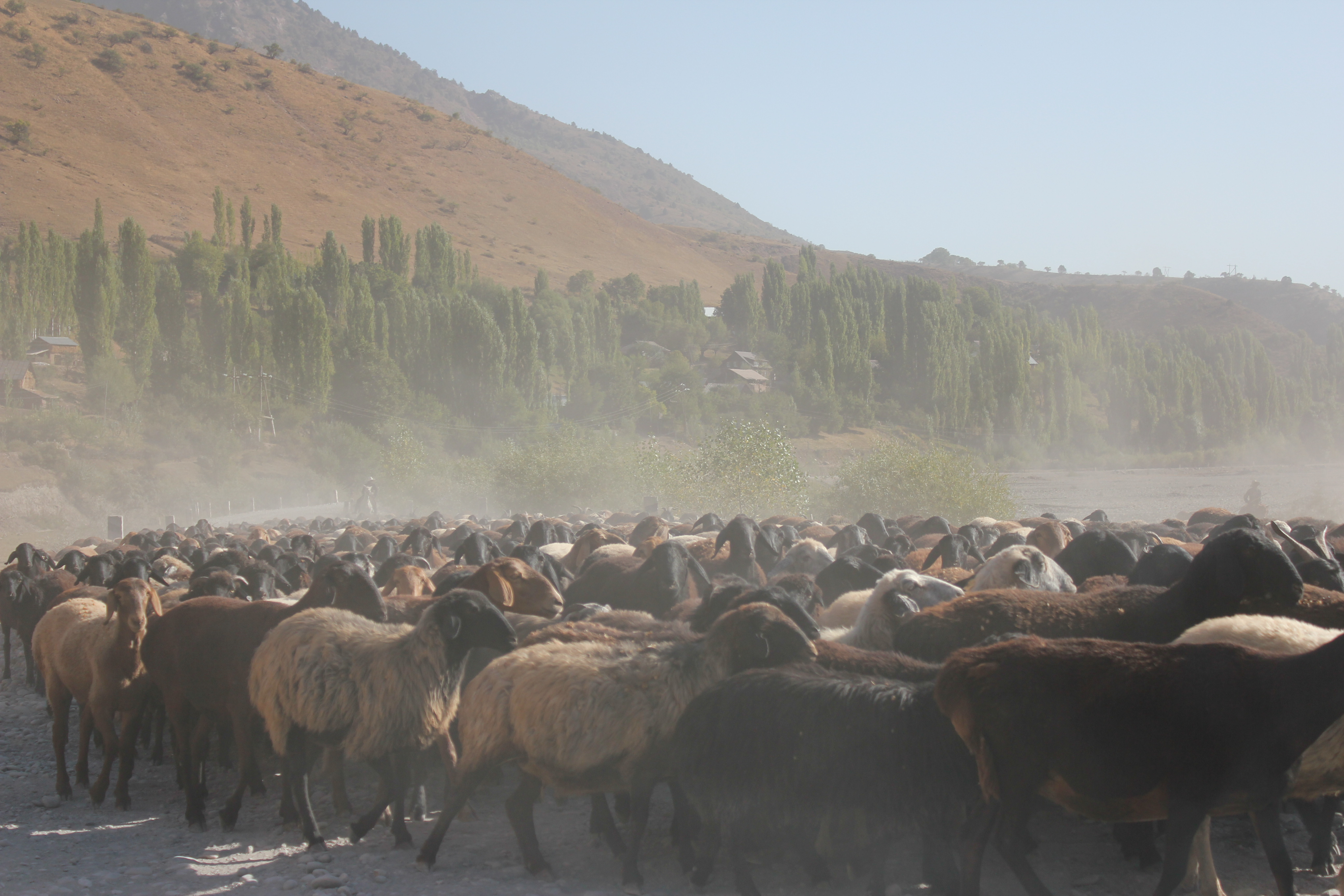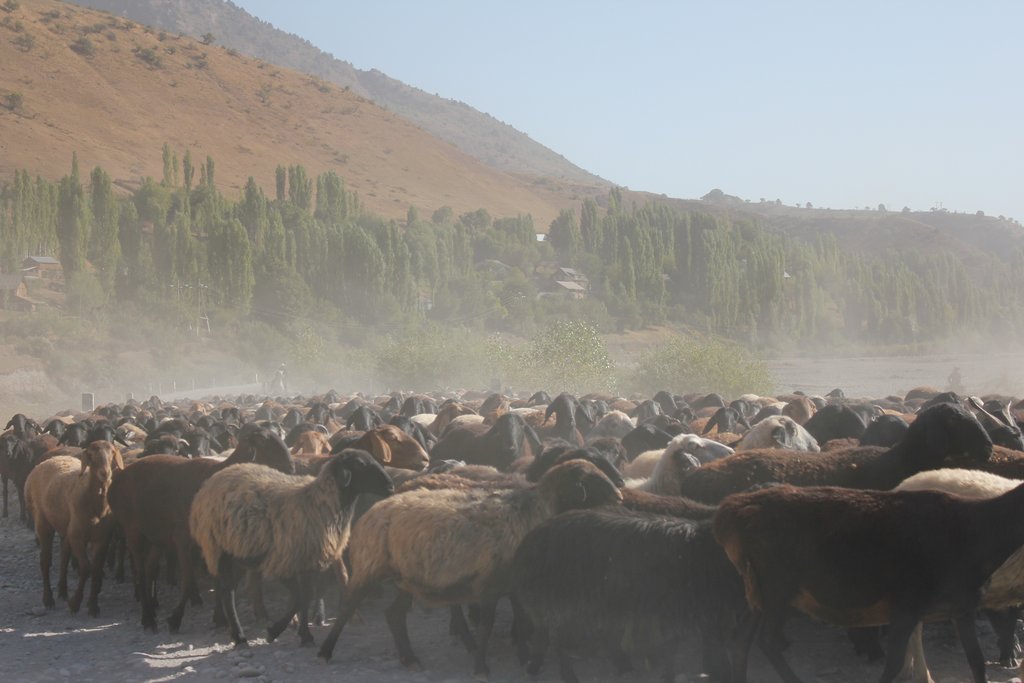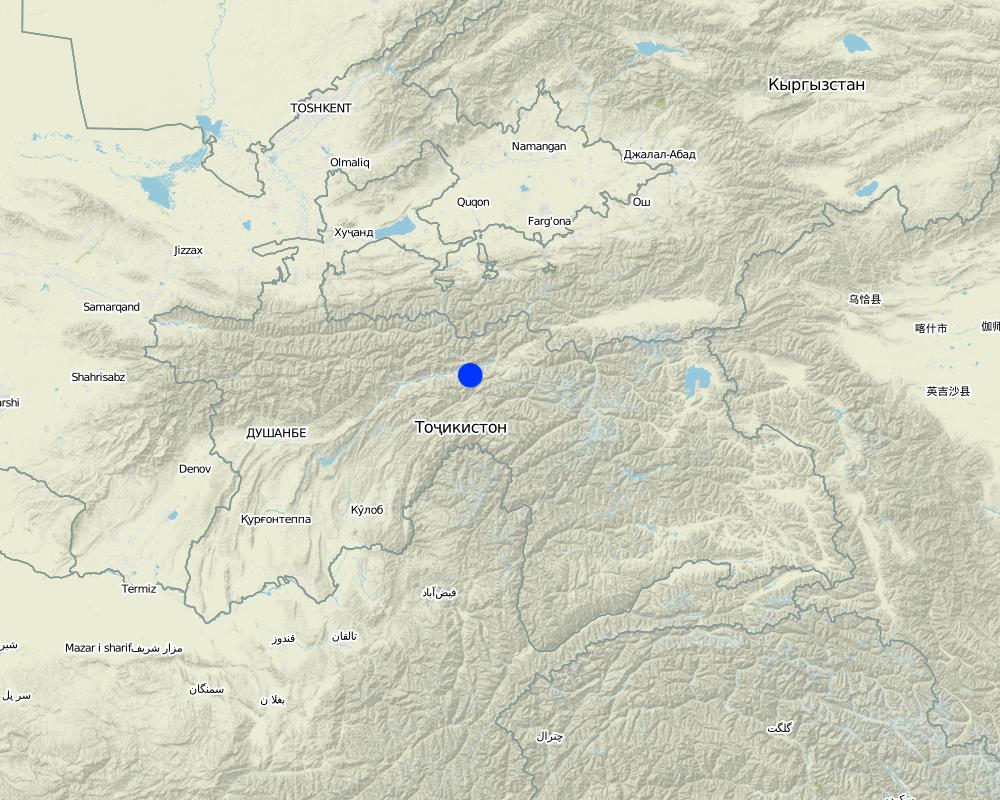Herds movement and roaming at different altitude/watershed zone [Tajikistan]
- Creation:
- Update:
- Compiler: Askarsho Zevarshoev
- Editor: –
- Reviewer: Farrukh Nazarmavloev
Бурдани чорво ба чарогоххои дур
approaches_3630 - Tajikistan
View sections
Expand all Collapse all1. General information
1.2 Contact details of resource persons and institutions involved in the assessment and documentation of the Approach
Name of project which facilitated the documentation/ evaluation of the Approach (if relevant)
Environmental Land Management and Rural Livelihoods (ELMAR)1.3 Conditions regarding the use of data documented through WOCAT
When were the data compiled (in the field)?
11/03/2018
The compiler and key resource person(s) accept the conditions regarding the use of data documented through WOCAT:
Yes
2. Description of the SLM Approach
2.1 Short description of the Approach
In this approach community take the opportunity to move their livestock along different pasture resources, which are located at different altitude. This is appropriate in mountains areas, where vegetation period starts in different period and community have access to fresh fodder for their animals. At this time they have the chance to save the pasture close to the village and crop land which they cultivate during summer time.
2.2 Detailed description of the Approach
Detailed description of the Approach:
In the mountain areas of Tajikistan pasture are distributed according to the seasonal use named also accordingly – winter/spring pasture and summer pasture. The winter pasture are usually are located in the upper zone of the watershed, while the winter/spring pasture are the one close to the community. Based on this delineation they are used in different season, because in the early spring, when snow just started melting in the close pasture in the remote pasture it is still covered by snow and not possible go to this areas. In this way community provide balance in use of pasture resource between different types of pasture resources along different altitude.
The approach is applied in a participatory way in agreement with all involved stakeholders, including community members/livestock owners, local government and other involved parties, such as herder from other communities. Community jointly in a village meeting in the early season of grazing plan for herds movements and assign responsible people with support of the village management to organize logistics.
Community is very much in favor to organize in such approach to move their animal to other places when at this period they save fodder and easily cultivate their crops land in the village. The only thing they do not like is that during this period they do not have to the dairy product, which could they get from their animals.
2.3 Photos of the Approach
General remarks regarding photos:
Community build special sheds in the pasture, where the livestock is kept during night time or when there is heavy rainy days. Sometimes, in the remote pasture community build similar but closed, which is also a mean to protect from wild animal, such as bear and wolf and sometime snow leopards.
2.5 Country/ region/ locations where the Approach has been applied
Country:
Tajikistan
Region/ State/ Province:
Rasht Vally, Lakhsh District
Comments:
The shed, which is called kashar in local language is a traditional approach, which is constructed jointly by community efforts, but sometime external funding also support with construction as part of pasture infrastructure development
Map
×2.6 Dates of initiation and termination of the Approach
If precise year is not known, indicate approximate date when the Approach was initiated:
more than 50 years ago (traditional)
Comments:
The approach is traditional way of movement herds along the pasture, while living in mountain communities.
2.7 Type of Approach
- traditional/ indigenous
2.8 Main aims/ objectives of the Approach
The main goal of this approach is to balance the availability of pasture resources availalbe for community to gain maximum benefit from existing fodder source in the surrounding areas.
2.9 Conditions enabling or hindering implementation of the Technology/ Technologies applied under the Approach
social/ cultural/ religious norms and values
- enabling
this is traditional approach and community members knowledge on this is transferred from generation to generation and does not have any limitation from social/cultural point of view. In fact traditionally the older generation is motivating youth to use the approach in order to use their pasture resource sustainably.
availability/ access to financial resources and services
- enabling
usually not much financial resource is required to implement the resource. The only this is need to organize community and manage their resource sustainably.
institutional setting
- enabling
traditional institutions, which deal with natural resource management exist from very beginning. When community motivated to establish their official institutions such as Pasture User Unions this is also enables community to plan according to the approach to move the herd from one pasture area to another during different season.
collaboration/ coordination of actors
- enabling
traditional all members of community is involved and aware of the approach, and also when official legal institute is established it also bring all stakeholder to plan for pasture grazing in a participatory way
legal framework (land tenure, land and water use rights)
- enabling
in a traditional way when applying the approach community know, which part of the pasture they own and plan accordingly, while when the official legal institute is established, such as PUU they obliged to gain certificate, which recognize their land use rights.
land governance (decision-making, implementation and enforcement)
- enabling
the approach is discussed in a participatory way among community members and agreed to implement accordingly.
knowledge about SLM, access to technical support
- enabling
this is traditional knowledge which is transfered from one generation to another generation, however when applied in the framework of project special technical team is assigned to support communities with implementation.
3. Participation and roles of stakeholders involved
3.1 Stakeholders involved in the Approach and their roles
- local land users/ local communities
community members, livestock owners
support with explaining the approach based on their traditional knowledge and provide evidence based information from their experiences
- community-based organizations
village organization, traditional community structures
guide community members and livestock owners on planing and implementing the approach.
- SLM specialists/ agricultural advisers
project technical team, specialist from respective research institutes, such as livestock institute
support with applying the technical aspect of the approach and awareness raising on the approach from science point of view.
- local government
respective local government departments, such as land committee, forestry department
supervise the implementation process and guide in applying the approach within framework
3.2 Involvement of local land users/ local communities in the different phases of the Approach
| Involvement of local land users/ local communities | Specify who was involved and describe activities | |
|---|---|---|
| initiation/ motivation | self-mobilization | traditionally community are used to apply approach every time when the season for grazing comes |
| planning | self-mobilization | existing community structure in the mountains areas come together in a community meeting to discuss and develop the plan for pasture use, which entails also applying the approach |
| implementation | interactive | usually community organize gathering dates for moving the herd, assign responsible person and agree with other stakeholders or pasture users from neighbor communities. |
| monitoring/ evaluation | passive | very passive monitoring is applied in monitoring the approach results and almost no research is involved. |
3.4 Decision-making on the selection of SLM Technology/ Technologies
Specify who decided on the selection of the Technology/ Technologies to be implemented:
- mainly land users, supported by SLM specialists
Explain:
mainly land users plan for applying the approach, only sometimes when any project implemented in the area the technical team is involved and sometime supported with specialist from local government
Specify on what basis decisions were made:
- personal experience and opinions (undocumented)
4. Technical support, capacity building, and knowledge management
4.1 Capacity building/ training
Was training provided to land users/ other stakeholders?
No
4.2 Advisory service
Do land users have access to an advisory service?
Yes
Specify whether advisory service is provided:
- on land users' fields
Describe/ comments:
government officials usually control the movement of the herd to the remote pasture, especially when there is crop season in the village.
4.3 Institution strengthening (organizational development)
Have institutions been established or strengthened through the Approach?
- yes, moderately
Specify the level(s) at which institutions have been strengthened or established:
- local
Describe institution, roles and responsibilities, members, etc.
mainly traditional village level structure, which include all community members and leaders to plan for village development. sometime supported by local government to enforce the implementation of the approach in order not to effect the crop production in the village/community.
4.4 Monitoring and evaluation
Is monitoring and evaluation part of the Approach?
Yes
Comments:
very few monitoring is done, usually by the officials of local government from agriculture department to make sure that the livestock is moved to the remote pasture and there is no grazing applied in the crop lands
If yes, is this documentation intended to be used for monitoring and evaluation?
No
Comments:
only reported by the government and from community to the head of the village organization
4.5 Research
Was research part of the Approach?
No
5. Financing and external material support
5.1 Annual budget for the SLM component of the Approach
If precise annual budget is not known, indicate range:
- < 2,000
Comments (e.g. main sources of funding/ major donors):
mainly from community of provision of vehicle and other source for infrastructure development, but some projects are also have contributing in construction of the infrastructure, including Environmental Land Management and Rural Livelihoods Project
5.2 Financial/ material support provided to land users
Did land users receive financial/ material support for implementing the Technology/ Technologies?
No
5.3 Subsidies for specific inputs (including labour)
- none
If labour by land users was a substantial input, was it:
- voluntary
Comments:
no construction work is required to implement the approach, only organization and management capacity is needed for community to apply the approach.
5.4 Credit
Was credit provided under the Approach for SLM activities?
No
5.5 Other incentives or instruments
Were other incentives or instruments used to promote implementation of SLM Technologies?
Yes
If yes, specify:
development of the community plan, which mobilize and give incentives to implement the approach
6. Impact analysis and concluding statements
6.1 Impacts of the Approach
Did the Approach empower local land users, improve stakeholder participation?
- No
- Yes, little
- Yes, moderately
- Yes, greatly
it brings all community members, which own livestock and motivate them join management of their resources.
Did the Approach build/ strengthen institutions, collaboration between stakeholders?
- No
- Yes, little
- Yes, moderately
- Yes, greatly
while the approach bring all stakeholders together to plan and manage their resource it also strengthens collaboration among them and improves their institutions.
Did the Approach mitigate conflicts?
- No
- Yes, little
- Yes, moderately
- Yes, greatly
the approach enables to agree and communicate the movement of the herd, which does not interfere into the other community areas.
Did the Approach empower socially and economically disadvantaged groups?
- No
- Yes, little
- Yes, moderately
- Yes, greatly
the approach is very inclusive and does not discriminate in participation of all groups. Those of who own livestock are equally participate
Did the Approach encourage young people/ the next generation of land users to engage in SLM?
- No
- Yes, little
- Yes, moderately
- Yes, greatly
the approach is used to be traditional and both youth and women are involved in promoting and implementing it.
6.2 Main motivation of land users to implement SLM
- increased production
when movement along all the pasture zone is taken place, this will lead burden to other parts and improved productivitiy
- increased profit(ability), improved cost-benefit-ratio
research results from other projects shows that movement among different types of pasture create an opportunity to use the potential production of pasture and get maximum increase in livestock productivity
- reduced land degradation
the approach in movement from one part to another place in the pasture leave space for the plot to fallow and regenerate
- conflict mitigation
6.3 Sustainability of Approach activities
Can the land users sustain what has been implemented through the Approach (without external support)?
- yes
If yes, describe how:
traditionally the knowledge on the approach is transferred from generation to generation, which guarantees the sustainability, in addition local government is involved to control and supervise the herd movement among different pasture types according to the season.
6.4 Strengths/ advantages of the Approach
| Strengths/ advantages/ opportunities in the land user’s view |
|---|
| traditional knowledge, simple and effective in livestock management and increasing production |
| Strengths/ advantages/ opportunities in the compiler’s or other key resource person’s view |
|---|
| compliant to the concept of pasture grazing between different areas |
| supported and motivated by government in order to control both the crop production and livestock production |
6.5 Weaknesses/ disadvantages of the Approach and ways of overcoming them
| Weaknesses/ disadvantages/ risks in the land user’s view | How can they be overcome? |
|---|---|
| when the livestock is moved to remote pasture the owners does not have access or limited access to dairy product | if the pasture infrastructure is well developed it will enable community and also herder to bring the dairy product to the village to sell and process |
| Weaknesses/ disadvantages/ risks in the compiler’s or other key resource person’s view | How can they be overcome? |
|---|---|
| very few monitoring is applied | community capacity should be build to monitor the implementation of the approach |
| research is not involved to recognize the effect of movement | collaboration between communities and research institute to establish and support government to mobilize research institutes |
7. References and links
7.1 Methods/ sources of information
- interviews with land users
various from community to community
- interviews with SLM specialists/ experts
3
7.2 References to available publications
Title, author, year, ISBN:
Pasture and Livestock Management Plan, Askarsho Zevarshoev, 2014
Available from where? Costs?
Free, from compiler
Links and modules
Expand all Collapse allLinks
No links
Modules
No modules





